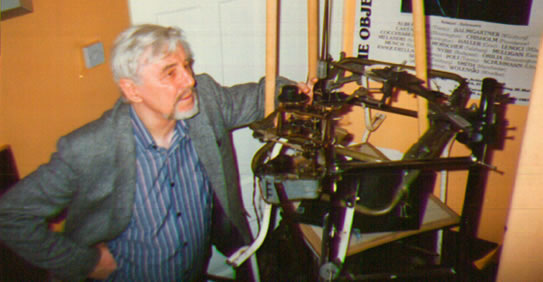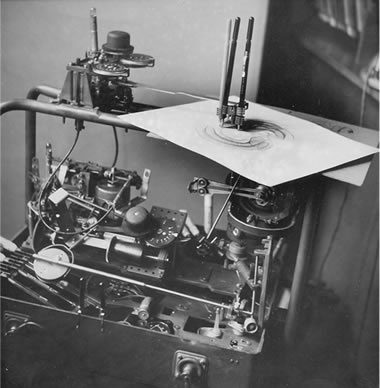About Desmond Paul Henry

Dr Desmond Henry at one of his drawing machines
Desmond Paul Henry (1921-2004) ranks among one of the few early British pioneers of Computer Art/Graphics of the 1960's. During this period he constructed a total of three mechanical drawing machines (in 1960, '63 and '67) based around the components of analogue bomb-sight computers. Henry's second drawing machine and its effects were included in the major Art and Technology exhibition of 1968: Cybernetic Serendipity (I.C.A, London).
Henry’s life-long passion for all things mechanical inspired him to purchase an army surplus analogue bombsight computer in the early 1950s. For years he would gaze transfixed at the ‘peerless parabolas’ (Henry) of its inner working parts when in motion. Then in the early sixties he decided to try and capture these mechanical motions on paper and so was born the first of a series of three drawing machines based around the components of the bombsight computer itself.
The Drawing Machines

The Avro Lancaster. Image courtesy of Getty Images
The bomb-sight computers, from which Henry constructed these machines in his home-based workshop in Manchester, were employed in World War Two Bomber Aircraft to calculate the accurate release of bombs onto their target. He combined these computers with other components to create electronically-operated drawing machines which relied mainly on a ‘mechanics of chance’. This meant the drawing machines could not be prep-rogrammed or store information as in a conventional computer; nor were they precision instruments.
As a result, Henry had only general overall control but at the same time he could intervene to direct the course of image production at any given moment of his choosing. This spontaneous interactive element of his machines pre-empted by some twenty years similar interactive features of contemporary graphic manipulation software. Today not one drawing machine remains in working order. In 2013, Dr. Jack Tait (www.taitographs.co.uk), expertly applied the principles of reverse engineering to create a Homage to Henry drawing machine capable of producing images similar to those of a Henry drawing machine, the latest version of which currently resides in the vaults of the London Science Museum, alongside the remnants of Henry's Drawing Machine Two.
The Machine Generated Effects

One of Henry's Drawing Machines
Using one or more mechanised drawing implements (biros at first and then tube pens with Indian ink) Henry’s drawing machines produced abstract, curvilinear, repetitive line drawings. Henry compared these strangely organic-type images to those described in natural form mathematics or produced using pendulum harmonographs and ornamental geometric lathes.
The chance element inherent in the construction and function of each Henry drawing machine ensured the unrepeatable quality of their infinitely varied visual effects. The aesthetic appeal of these ‘mechanical fractals’ (Henry) lies in their unique blend of order and chaos, of regularity and irregularity.
These machine-produced images were either left untouched by Henry or embellished further by hand in response to their suggestive features.
Did you know? Desmond Paul Henry Facts
- Henry grew up in Huddersfield in the 1920’s.
- His stated aim at the age of 9 was to be another Leonardo Da Vinci.
- Henry took part in the Normandy Landings in June, 1944.
- Henry met and then married a Belgian girl living in Brussels, Louisa Bayen.
- L.S Lowry encouraged Henry to continue to experiment with his ventures in art.







